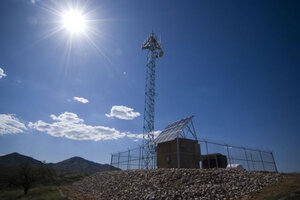'Virtual' border fence idea revived. Another 'billion dollar boondoggle'?
The Obama administration wants to build a virtual border fence of sensors and cameras in Arizona. But an earlier attempt failed and questions about the new plan are mounting.

This picture shows a prototype of a tower in Playas, N.M., for the ambitious, $6.7-billion virtual border fence plan that was abandoned in 2011. The Obama administration is moving forward with a new plan.
US Customs and Border Protection/AP/File
Tucson, Ariz.
Customs and Border Protection's Mark Borkowski has his pitch down. At a hearing of the House Homeland Security Subcommittee on Border and Maritime Security last week, he painted a portrait of what his agency's new plan to build a high-tech virtual fence along the Arizona portion of US-Mexico border would look like.
As many as 50 fixed towers that could detect illegal activity from miles away with cameras, radars, and sensors would be deployed as part of the Arizona Border Surveillance Technology Plan. Other equipment, some of it already in use, would expand a network of ground sensors and the number of hand-held thermal imaging devices that allow agents to see at night.
But as the plan moves forward, it is running into criticism from lawmakers and officials who remember how things turned out the last time the federal government tried this. Under President George W. Bush, the Department of Homeland Security (which oversees CBP) started a grand plan to blanket the 2,000-mile border in a high-tech virtual fence. In 2011, the Obama administration killed the program, called SBInet, which had covered 53 miles and cost $1 billion.
Intense heat and inclement weather destabilized equipment. Sensors tracked animals instead of humans. It was, in the end, "a billion dollar boondoggle," Rep. Beto O'Rourke (D) of Texas said at last week's hearing.
This time will be different, said Mr. Borkowski, CBP's assistant commissioner for the Office of Technology Innovation and Acquisition. The equipment has been tested in a similar environment to Arizona (Israel), and "what we saw in the demos was very impressive," he said at the hearing.
Moreover, CBP will be trying to do less with less. Israel's Elbit Systems, which also was involved with SBInet as a Boeing subcontractor, will begin installing towers this year as part of an overall project whose cost is estimated between $500 million and $700 million over 10 years.
But concerns are still percolating on Capitol Hill and beyond. Representative O'Rourke worries that illegal cross-border traffic is shifting to Texas, meaning the Arizona project is behind the times. And a report from the Government Accountability Office (GAO) released last week cautions that if CBP fails to strengthen oversight and expand testing of the fixed surveillance towers – the plan's highest expense – the project could repeat the failures of SBInet.
For an agency determined to bring high-tech solutions to the border, CBP's new gambit is fraught with high stakes.
CBP says the new, slimmer project will work because it is composed of tried and tested equipment tailored to distinct parts of the border. By contrast, SBInet had a one-size-fits-all approach for the entire stretch. Moreover, with SBInet, Boeing Co. wanted to develop new technology, Borkowski said. Though Elbit's towers are similar to SBInet's, they are simpler, more flexible, and "off-the-shelf."
Elbit Systems, based in Haifa, works with Israeli police to help secure the country's air, sea, and land entry points with its border control systems.
At the hearing, Borkowski acknowledged limited testing of the towers and agreed that CBP needs to collect better data on exactly how technology helps agents nab illegal border-crossers and drug smugglers. The idea is for the system to seamlessly record illegal border crossings and transmit the information to computers at a command center that can dispatch agents to identified locations as needed.
The GAO report cited lack of clear performance metrics, a master schedule, and life-cycle cost estimates as risks.
The project is already behind schedule, and the flow of illegal border crossings has begun shifting to Texas from Arizona. The border patrol's Tucson sector recorded the highest number of arrests along the southern border for nearly two decades, but in fiscal year 2013 it recorded 33,514 fewer than its Rio Grande Valley counterpart, which recorded 154,453.
While Congress members aired concerns last week, only O'Rourke called for suspending the project until CBP addresses identified weaknesses.
"I'm worried that we're going to have something akin to SBInet again," he said.
Subcommittee members said they would be keeping close tabs on the project, something lawmakers in Arizona also emphasize.
"I have seen firsthand the waste of taxpayer dollars, and I am determined that will not happen with this project," said Rep. Ron Barber (D) of Arizona in a statement. His congressional district includes a large swath of the border.
The failure of SBInet was due in part to its complexity, says Christopher Bronk, an information technology fellow at Houston's Rice University.
"It was a big, heavy, intelligence solution that was probably too ambitious for the mission and ended up becoming pretty expensive," he says.
He thinks the Arizona plan, with solid performance measurements and effective management, has a good chance for success.
The watchdog group Taxpayers for Common Sense was no fan of SBInet, and the group's vice president, Steve Ellis, says he can't help but feel skeptical about the Arizona plan.
"Is it really necessary, is it going to be effective, is it going to return on the taxpayers' investment?" he says. "These are all legitimate questions."
For the National Border Patrol Council, the union representing agents, technology often can assist boots on the ground to do their job efficiently, provided it's the right fit, says spokesman Shawn Moran.

